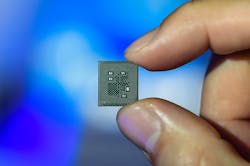Qualcomm is trying to tighten its grip on the high end of the smartphone market with a new top-end processor promising 10% more performance than its predecessor, offering clock speeds of over 3 GHz for the first time in a mobile SoC. The chip also doubles the speed of WiFi connections compared to its former flagship product in its popular Snapdragon series.
The new chip, the Snapdragon 865+, is an improved version of its top-end chip for flagship smartphones, the Snapdragon 865, which is used in around 140 devices on the market or in development. The Snapdragon 865 was also used in first-generation 5G smartphones from Samsung, LG, and other phone manufacturers rolled out last year with price tags of more than $1,000. Both chips are based on the 7-nanometer process node from TSMC.
Qualcomm has long been the world's largest vendor of smartphone chips. It tends to roll out a new flagship processor every year, followed by an enhanced SKU roughly half a year later.
Qualcomm said it upgraded the central processing unit (CPU) in the Snapdragon 865+, which uses large, high-performance cores and small, energy efficient cores to boost battery life. The chip contains Qualcomm’s Kryo 585 CPU with four Cortex-A77 cores. One of these cores—the "Prime" core—is clocked at 3.1 GHz and contains 512 KB of L2 cache, pumping out 10% more performance than the Snapdragon 865, which is clocked at up to 2.84 GHz.
The remaining Cortex-A77 cores have a top frequency of 2.42 GHz and incorporate 256 KB of L2 cache. These cores are balanced out by four Cortex-A55 CPU cores clocked at 1.80 GHz and containing caches of 128 KB caches—the same cluster of small, power-sipping cores crammed in the Snapdragon 865, according to Qualcomm. The eight-core CPU is connected to 4 MB of L3 cache and 3 MB of system level cache, the company said.
The memory subsystem has support for LPDDR4 lanes with up to 2.13 GHz clock speeds or LPDDR5 lanes with 2.75 GHz speeds. The chip can accommodate up to 16 GB of DRAM.
The new chip incorporates the same Qualcomm's Adreno 850 GPU as the Snapdragon 865. But it boosts performance by up to 10% over its predecessor, promising improvements for mobile gaming. The faster GPU brings lusher colors, sharper details, faster load times and smoother, realistic graphics for people playing games on their handsets. The speed boost also enhances the color, sharpness and brightness of details rendered on the display.
The other upgrade in the Snapdragon 865+ is to the WiFi subsystem. Qualcomm said the chip's newFastConnect 6900 subsystem delivers data rates of up to 3.6 Gbps over new WiFi 6 networks, which is faster than any other smartphone chip currently on the market. The chip is capable of tapping into the 6 GHz band used in newer WiFi networks—as well as the current 2.4 GHz and 5 GHz WiFI frequency bands—to offer faster data transfers.
By allowing devices to transfer data over a wider range of bands at the same time, the Snapdragon 865+ can dramatically speed up connections to the latest WiFi 6 networks.
The chip also adds Bluetooth 5.2, dual Bluetooth antennas, an advanced audio codec, and new BLE features that combine to bring out clearer, sharper wireless audio to smartphones.
It also shares the same Spectra 480 image signal processor (ISP) as its predecessor, which can process more than a billion pixels per second. The dual-core ISP can also process data from more advanced cameras in flagship smartphones, improving image capture rates and shooting high-resolution video with higher frame rates. It adds computer vision to speed up the processing of HDR photographs and sharpen blurry images captured in dim lighting.
Like the Snapdragon 865, the chip must be paired with a separate modem, the X55, to connect to emerging 5G networks. The X55 5G modem delivers download speeds of up to 7.5 Gbps with uploads of up to 3 Gbps over the full range of 5G frequency bands, including the sub-6 GHz and millimeter waves. The X55 also has a 4G LTE modem, which handles data transfer rates of up to 2.5 Gbps and maximum uploads of 300 Mbps, Qualcomm said.
Using a discrete modem impacted the cost, power and size of early 5G devices. Qualcomm plans to introduce its high-end 8-series chips with integrated 5G modems later in the year.
Qualcomm is looking to take advantage of its early lead in 5G technology, which it believes will breathe new life into the smartphone segment, which has stagnated in recent years. It is looking to roll out its 5G modems to the billions of people unable to afford handsets with the wireless technology inside. It has started adding advanced 5G modems to chips for use in midrange and budget smartphones that cost less than $500.
Qualcomm said the first products based on its Snapdragon 865+ would be introduced this quarter by Lenovo, Asus and other phone makers. “As we work to scale 5G, we continue to invest in our premium-tier, 8-series mobile platforms, to push the envelope in terms of performance and power efficiency and deliver the next generation of camera, AI and gaming experiences," said Alex Katouzian, head of Qualcomm's mobile division.
About the Author
James Morra
Senior Editor
James Morra is the senior editor for Electronic Design, covering the semiconductor industry and new technology trends, with a focus on power electronics and power management. He also reports on the business behind electrical engineering, including the electronics supply chain. He joined Electronic Design in 2015 and is based in Chicago, Illinois.

